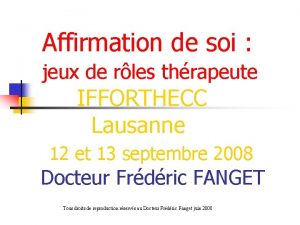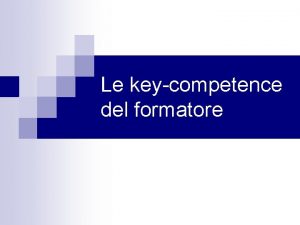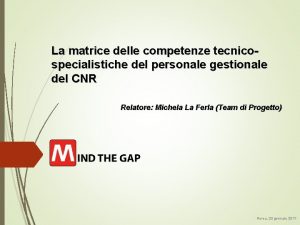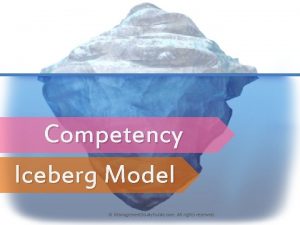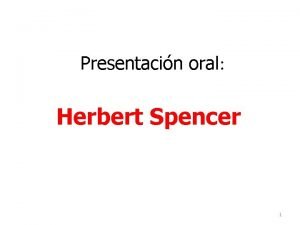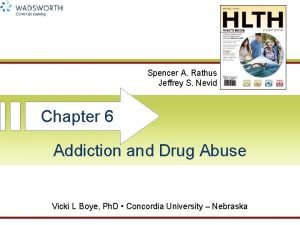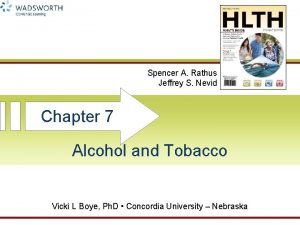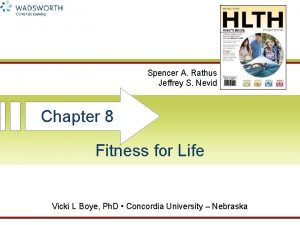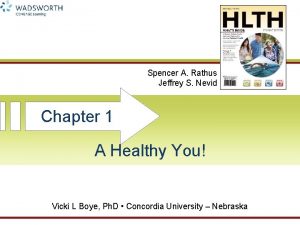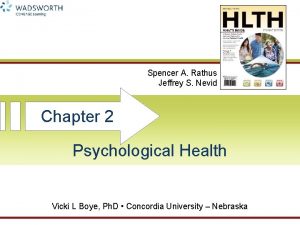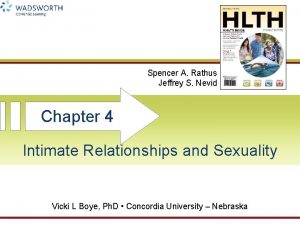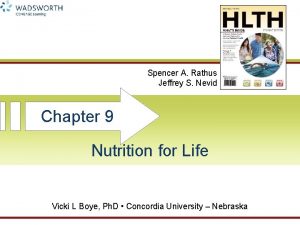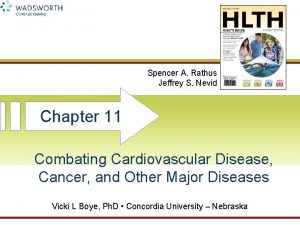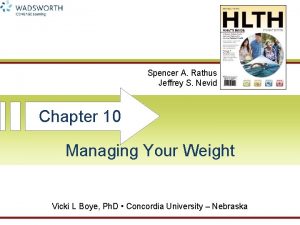Spencer A Rathus Jeffrey S Nevid Chapter 5















- Slides: 15

Spencer A. Rathus Jeffrey S. Nevid Chapter 5 Reproductive Choices Vicki L Boye, Ph. D • Concordia University – Nebraska

Chapter 5 Reproductive Choices Learning Outcomes: § § § § Describe the process of conception Discuss the problem of infertility and alternate methods of having children Discuss the pros and cons of various methods of contraception Discuss methods of abortion Discuss health issues in pregnancy and prenatal development Describe health issues associated with methods of childbirth Discuss health issues in the postpartum period

Conception • • Union of a sperm cell and an egg cell Zygote: Fertilized egg Females: XX Males: XY Miscarriages (spontaneous abortions) of male fetuses more prevalent • Fertilization normally occurs in a fallopian tube. The zygote travels down to the uterus and implants into the wall.

Infertility • Male Fertility Problems • Sperm: low count, low motility, irregularly shaped • Causes: genetic factors, age, injuries, drugs, blood pressure medications, environmental toxins, stress • Female Fertility Problems • Irregular ovulation or failure to ovulate, obstructions or malfunctions of reproductive tract, endometriosis, age-related decline of female sex hormones

Increasing Fertility • Increasing the sperm count Artificial insemination • ICSI (Intracytoplasmic Sperm Injection) • Inducing Ovulation • • IVF (Invitro fertilization) GIFT (game intrafallopian transfer) Donor IVF ZIFT (Zygote intrafallopian transfer) Embryonic Transfer Surrogate Motherhood Adoption

Contraception Consider effectiveness, ease of use, health risks § Hormonal Methods o o o progestin or combination of progestin and estrogen Oral contraceptives – “The Pill” Injectable, patches, “morning-after pill” No protection against STIs Health risks for women who smoke, are obese, older, hypertension, or a history of vascular disease § Intrauterine Device (IUD)

Contraception Methods § Barrier Methods Condoms o Latex protect against STIs o Less effective than oral contraceptive or IUD Diaphragm o Shallow latex cup or dome o No protection against STIs Spermicides Contraceptive Sponge Cervical cap

Contraceptive Methods § Fertility Awareness (Rhythm Methods) Calendar BBT Ovulation • No protection against STIs • Low reliability § Sterilization • Vasectomy • Tubal sterilization (tubal ligation) • Hysterectomy

Abortion Purposeful termination of pregnancy § Methods o Vacuum aspiration (90% - safest) o Dilation and Curettage (D & C) o Dilation and Evacuation (D & E) – 2 nd trimester o Intra-amniotic infusion – 2 nd trimester o Intact Dilation and Extraction (intact D & E) o RU-486

Pregnancy • Early Days • Human chorionic gonadotropin (HCG) produced (OTC pregnancy tests – HCG in urine) • “morning sickness” • Prenatal care important

Stages of Prenatal Development Germinal Stage Conception to implantation Embryonic Stage Implantation to 8 th week Neural tube (3 weeks) – importance of folate Fetal Stage 9 th week until birth Major organ systems, fingers, toes, external genitals are formed by end of 1 st trimester Factors that may adversely affect health of embryo/fetus: drugs, X-rays, environmental contaminants, infectious organisms

Childbirth Three Stages 1 st Stage: Labor - contractions efface and dilate cervix, ending with transition 2 nd Stage: transition, “hard labor” culminating with delivery 3 rd Stage: Delivery/Expelling of Placenta

Methods of Childbirth § Anesthetized Childbirth • General • Local: Blocks – pudendal, epidural, spinal § Prepared Childbirth – The Lamaze Method • Can be used in combination with anesthetics § Cesarean Section • 1 in 3 births now done by C-section

Birth Problems § Oxygen Deprivation • Prenatal hypoxia can impair central nervous system development • Prolonged oxygen cutoff at delivery can cause cerebral palsy or death § Preterm and Low-Birth Weight Children • Preterm < 37 weeks Low birth weight < 5 lbs • Neurological and cognitive functioning impaired • Muscles are immature, weakened sucking & breathing reflexes • Respiratory distress syndrome

The Postpartum Period § Postpartum Depression (PPD) • “baby blues” normal – generally last 1 -2 weeks • PPD – more serious and persistent mood changes Symptoms: sadness, hopelessness and helplessness, major changes in appetite, sleep patterns, difficulty concentrating, severe fluctuation in mood § Breast-Feeding Versus Bottle Feeding • Benefits of Breast-Feeding Reduces risks of infections, and incidence of allergies
 Psychology principles in practice spencer a rathus pdf
Psychology principles in practice spencer a rathus pdf Nevid insekt
Nevid insekt échelle d'affirmation de soi de rathus
échelle d'affirmation de soi de rathus Spencer and spencer
Spencer and spencer Iceberg delle competenze di spencer
Iceberg delle competenze di spencer Modello iceberg di spencer e spencer
Modello iceberg di spencer e spencer Matrice delle competenze
Matrice delle competenze Spencer and spencer 1993
Spencer and spencer 1993 Iceberg model competency
Iceberg model competency Percy spencer
Percy spencer Herbert spencer contribution to sociology
Herbert spencer contribution to sociology Philosophy of herbert spencer in education
Philosophy of herbert spencer in education Biografia de herbert spencer
Biografia de herbert spencer Infrspinatus
Infrspinatus Parents de diana spencer
Parents de diana spencer Spencer axani
Spencer axani


